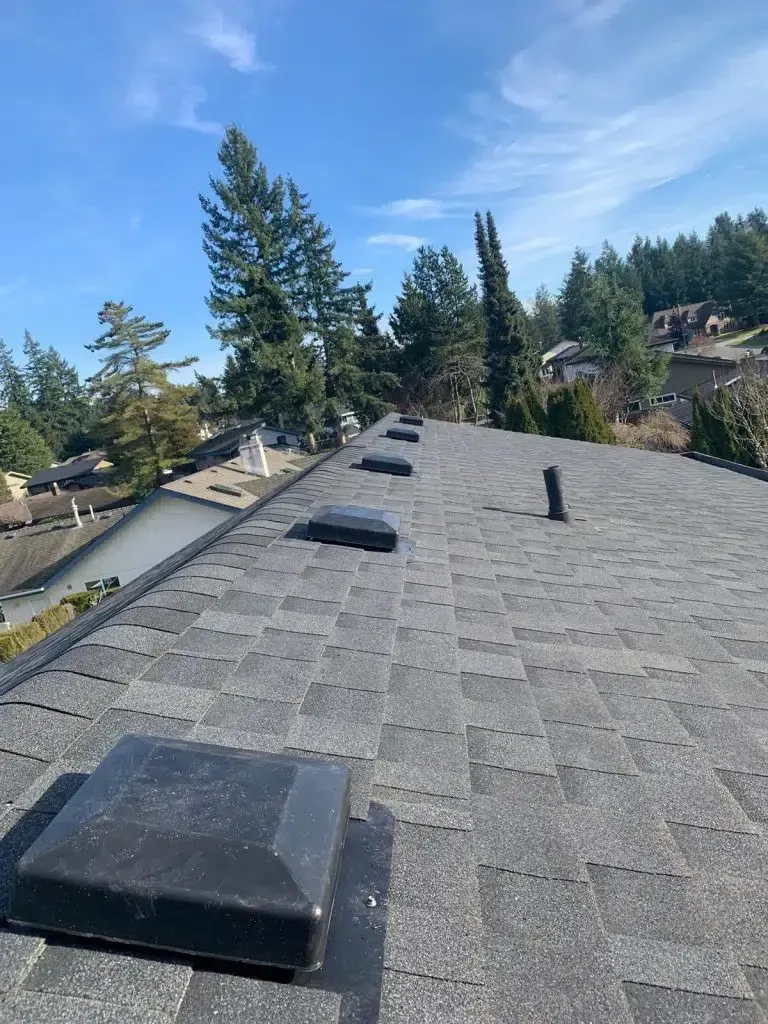How Coastal Winds Impact Burnaby Roofs and What to Do About It
Coastal winds buffet Burnaby roofs year-round, loosening shingles, driving rain sideways, and fatiguing flashing; to safeguard coastal winds Burnaby roofs, install wind-rated materials, reinforce edges, and book annual inspections.
- Choose Class H wind-rated shingles.
- Reinforce eave and ridge edges.
- Install corrosion-resistant fasteners.
- Seal penetrations every spring.
- Schedule pre-storm roof inspections.
| Factor | Value | Note |
|---|---|---|
| Peak gusts | 70–90 km/h | Typical Metro storms |
| Shingle rating | Class H | Withstands 210 km/h |
| Inspection interval | 12 months | Before windy season |
Salt-Tanged Gusts, Cedar-Scented Streets: Why Burnaby’s Wind Tells a Different Roofing Story
Step outside on a winter night near Burnaby Mountain and you’ll hear it—a restless, sea-born roar funneling through the Fraser delta, whipping over Still Creek, rattling siding, snapping trampoline nets, and tugging at every unprotected shingle like a mischievous child testing loose teeth. Those same gusts that give the city its fresh, briny air also conspire against your roof’s longevity. As the lead installer and project estimator at Paragon Roofing BC, I’ve spent two decades watching wind shape the lifespan of Burnaby’s rooftops. Below is an in-depth, 2,000-plus-word exploration—equal parts meteorological detective work and hands-on field notes—on how coastal winds behave here, the silent damage they inflict, and the practical steps you can take right now to keep your home’s first line of defence intact.
1. The Anatomy of a Burnaby Gale
Burnaby straddles salt water and mountains, so our wind is rarely steady; it pulses. Environment Canada records show a clear seasonal rhythm: a “windier half-year” from late October through early April, with average hourly speeds exceeding 4.4 mph (≈7 km/h) and December peaking at 6 mph (≈10 km/h) . But statistics feel tame until a squall barrels in. Thunderstorm watches routinely warn of 70 km/h gusts , and Christmas-week Pacific lows have spiked 90 km/h across the Lower Mainland’s exposed caps .
Those numbers matter because uplift pressure increases with the square of wind speed. A 70 km/h gust isn’t just 40 % stronger than a 50 km/h breeze—it can yank with roughly double the force. When gusts angle up the south slope of Capitol Hill, they accelerate, forming vortices along ridges and corners that want to pry shingles like pages of an old paperback.
2. Five Invisible Forces Chewing at Your Roof
- Uplift Vortices: Wind rushing over the roof edge drops in pressure, producing a lifting vacuum at eaves and rakes.
- Flutter Fatigue: Repeated micro-movements loosen adhesive strips on shingles, eventually snapping nails.
- Wind-Driven Water: Rain rarely falls vertical in Burnaby; it rides the wind sideways, probing beneath lap joints.
- Salt & Abrasion: Aerosolised sea salt etches metal flashings; airborne cedar needles sand-blast granules.
- Pressure Pulses: Large gusts create sudden interior-exterior pressure differentials, stressing sheathing fasteners.
These factors seldom destroy a roof overnight; they nibble. A missed nail here, a lifted ridge cap there—compound that over 1,500 storm cycles and failure feels “sudden,” though it was quietly baked in.
3. Material Science Meets Marine Air
3.1 Shingle Ratings Aren’t Suggestion Stickers
Burnaby’s by-law references the BC Building Code, which points to ASTM D7158 wind-uplift classes. For asphalt shingles we insist on Class H (210 km/h lab rating) even though you’ll “only” see 90 km/h in the real world; that 130 km/h buffer covers gust peaks plus installation variables. Lower-rated Class D (161 km/h) fails early along Barnet Highway where the inlet funnels wind directly inland.
3.2 Metal Matters—But So Do Clip Counters
Standing-seam steel is trending for its sleek lines, yet the hidden clips must correspond to local wind zones. Coastal Burnaby requires clip spacing as tight as 12 inches on centre near eaves; stretch that to 18 inches and panels can “oil-can” or outright peel in a frontal gust.
3.3 Corrosion Is a Slow Saboteur
Saline mist rides up the Burrard Inlet, settling on your roof like invisible frosting. Electro-galvanized nails rust through in a decade; we use hot-dipped or stainless. I have personally pried shingles off a 15-year-old roof on Pandora Street where every second nail head was missing—evaporated into rust dust.
4. Case Study: The Pineapple Express of November 2021
A sub-990-mb Pacific low collided with an atmospheric river on 14 November 2021. Paragon logged 37 emergency tarping calls in 12 hours. Common failures:
- Ridge caps peeled on 9- and 12-in-12 roofs where installers skipped extra nails.
- Two-year-old laminated shingles on a duplex had edge blow-offs—factory seal not heat-activated by cool November install temps.
- A new TPO flat roof showed corner uplift after HVAC techs removed ballast pavers and never replaced them.
Each fix involved not just patching but addressing root causes: edge metal length, mechanical fasteners, and proper sealant selection.
5. Inspection Protocols Tailored to Wind-Wear
| Inspection Tool | Purpose | Frequency |
|---|---|---|
| Drone flyover | Spot torn tabs & lifting | Post-storm |
| Moisture meter | Detect deck saturation | Annual |
| Thermal camera | Identify insulation gaps & wind-washing | Every 2 years |
| Fastener torque check | Confirm metal clip retention | 5-year interval |
Pro tip: schedule ground-based binocular checks immediately after any storm in which local stations log gusts ≥70 km/h; you’ll often catch fresh raised tabs before the next rainfall drives water under them.
6. Maintenance Best Practices for Wind-Exposed Roofs
- Edge-Metal Tune-Ups: Tighten or replace loose drip-edge nails; add a bead of polyurethane sealant under the flange.
- Sealant Refresh: Re-caulk pipe boots and skylight pans; UV and flexing break down elastomer in 3–5 years.
- Granule Check: Brush debris gently, don’t power-wash; high-pressure fans accelerate granule loss.
- Tree Pruning: Limb back overhanging cedars; branches act like whips during gusts, scouring shingles.
- Attic Pressure Balance: Ensure soffit vents aren’t blocked; equalised pressure reduces uplift from interior air bursts.
7. Retrofit & Hardening Strategies
7.1 Hurricane Clips & Nail Patterns
Most Burnaby homes built pre-1990 rely on toe-nailed trusses. Retrofitting Simpson H1 or H10A clips boosts deck uplift resistance by up to 50 %. Combine that with a 6/6 nail pattern (versus code-minimum 4/6) for plywood and you create a continuous load path.
7.2 Secondary Water Barriers
Self-adhesive ice-and-water membrane along eaves and rakes prevents wind-driven rain from wicking under shingles. In zones where gusts exceed 70 km/h at least twice per year (our data points to South Slope and Capitol Hill ridgelines), we extend membrane 36 inches up the deck.
7.3 Ventilation Upgrades
High-flow ridge vents sit directly in the wind stream. Opt for baffled styles that block wind-driven rain yet allow vapour escape. Installation must include continuous beads of butyl underneath to prevent lift.
8. Insurance, Code, and Real-World Claim Lessons
- Policy Sub-Limits: Many home policies cap wind damage at roof replacement “actual cash value,” not replacement cost. Review your wording.
- Documentation: Drone screenshots with time stamps accelerate claims.
- Permit Proof: Burnaby’s online portal stores permits back to 2005; attach copies to show code compliance.
- Up-grades vs Repair: If 25 % of a slope is damaged, insurers often allow full-slope replacement to preserve warranty continuity—leverage that.
9. DIY vs. Professional Intervention
Could a diligent homeowner slap down a tube of sealant and call it good? Sometimes. But wind damage hides. I’ve seen shingles—with intact upper surfaces—where the adhesive strip was sheared off underneath, ready to blow next gust. We bring moisture meters, core-cut kits, torque wrenches for metal hardware, and manufacturer tech bulletins on acceptable repairs. If you insist on DIY, at least pony up for a spring/fall inspection plan. One blown tab can funnel gallons of rain down an open butt joint into insulation, silently moulding drywall for months.
10. The Ultimate Wind-Hardening Checklist
- Class H or better shingles or mechanically-locked metal.
- Stainless, ring-shank nails, 1¼ in.
- 36 in. peel-and-stick perimeter membrane.
- Drip edge overlapping fascia by ≥2 in.
- Hurricane clips on every truss end.
- Continuous, baffled ridge vent with butyl strip.
- Attic insulation baffles to maintain airflow.
- Annual post-storm drone survey.
11. Frequently Asked Questions
How often should I re-nail loose ridge caps?
Every three years, using 11-gauge ring-shanks and a dab of asphalt cement underneath.
Do metal roofs ever lift in Burnaby?
Yes, if clip spacing exceeds 18 in. near edges or installers ignore “fixed-clip at ridge, sliding at mid-panel” rules.
Will my solar panels increase uplift?
Only if racking lacks wind deflectors. Ask for rails rated to CSA A370 wind loads.
Can I claim a tax credit for wind-resistant upgrades?
BC’s current rebates favour energy, not resilience, but increased airtightness from new sheathing often qualifies under the Home Renovation Rebate Program.
12. Conclusion: The Wind Will Keep Blowing—Your Roof Shouldn’t
Burnaby’s postcard skyline hides a paradox: gentle sea breezes for the jogger on the Brunette River Trail, yet savage, invisible fists pummelling rooftops just a few metres above. Understanding that duality—and building or retrofitting with it in mind—spells the difference between a minor maintenance bill and a tarp flapping at 3 a.m. The strategies above aren’t ivory-tower theory; they are field-tested repairs my Paragon crews perform after every autumn squall. Adopt them and coastal winds stop being a lurking threat and become what they should be: the fresh, invigorating pulse of a city by the sea, heard from the comfort of a bone-dry, wind-tight home.
If you’re considering weatherproof roofing in Burnaby , our team is ready to help.
References: Environment Canada storm bulletins (70 km/h gust warnings) ; CityNews report on coastal wind warnings (90-120 km/h) ; WeatherSpark average wind-speed data for Burnaby (seasonal trends) .



